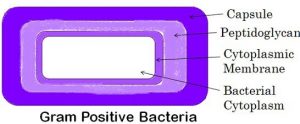Gram-positive bacteria are bacteria identified in the staining process by the colour they turn. In 1884, the staining method was invented by Hans Christian Gram. Crystal violet dye, which is preserved by the thick peptidoglycan cell wall present in gram-positive species, is used in the staining process. When seen under a microscope, this reaction gives gram-positive species a blue hue.
Gram-positive bacteria may be cocci or bacilli or branching filaments.

Streptococci
- Streptococci are gram-positive bacteria and are spherical.
- They are divided into parallel planes, resulting in formation of chains. Some cells are aerobic and others are anaerobic.
- There are two kinds of bacteria that are gram-positive-alpha-hemolytic and beta-hemolytic.
- Alpha hemolytic species on Blood agar partially kill red blood cells, while blood cells are entirely killed by the beta-hemolytic species.
- Other streptococci species that cause no disruption of blood cells are gamma-hemolytic.
- Many dangerous streptococci species will cause secondary bacterial, sore throat and viral pneumonia, whereas dental caries include other species.
- In the processing of yogurt, buttermilk, and cheese, certain harmless strains of streptococci are used.
Staphylococci
- Staphylococci are Gram-positive.
- They divide into planes and produce clusters or packets. They usually thrive on the skin and mucous membranes. Few species produce the enzyme coagulase, which causes blood clotting. Staphylococcus aureus is involved in cases of food poisoning.
Lactobacilli
- Lactobacilli are Gram-positive.
- They are rod-shaped bacteria.
- They can be single-celled or in the form of chains.
- These are well known for producing lactic acid in their metabolism.
- They are involved in the production of dairy products.
- They are also associated with the flora of the mouth as well as the vagina.
Bacillus and Clostridium species.
- These Gram-positive rod-shaped bacteria
- Their endospores are highly resistant.
- The Bacillus species grow aerobically whereas Clostridium species grow anaerobically.
- Bacillus anthracis causes the disease anthrax and different species of Clostridium cause tetanus, botulism.
- Some industrial purposes require the utilization of both Bacillus and Clostridium species.
Corynebacteria
- Corynebacteria are Gram-positive rod-shaped bacteria.
- The presence of cytoplasmic phosphate granules is seen in the bacterial cell. These granules are metachromatic granules. Corynebacterium diphtheriae can cause human diphtheria.
Actinomyces and Arthrobacter.
- These are Gram-positive rod-shaped bacteria.
- Most species are anaerobic. They exhibit many shapes during their life cycles.
- They acquire many shapes including branching rods, spherical forms and usually branching filaments. Arthrobacter species are mainly found in the soil.
- Many of the species degrade herbicides and pesticides.
REFERENCES
